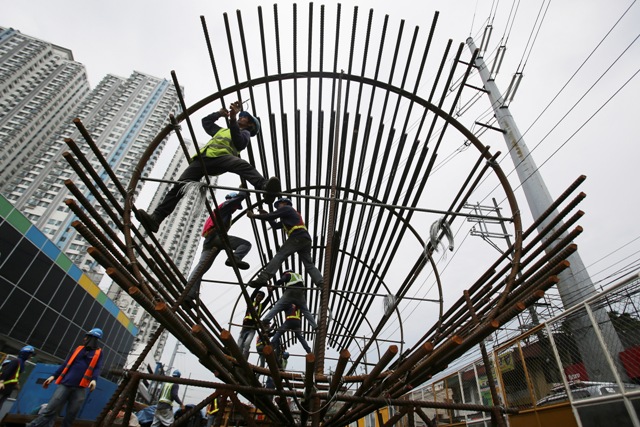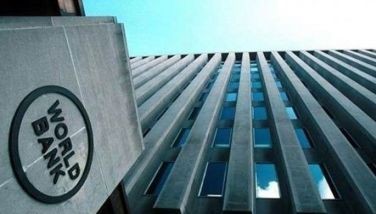YearEnder: Private firms struggle to find role in Build Build Build

The Philippines, after all, remains largely a consumer-driven economy, and so government spending on a robust pipeline of big-ticket infrastructure projects in and out of the capital will move the production and consumption of goods and services at an unprecedented pace. File
MANILA, Philippines — It’s almost impossible not to talk about the domestic economy and the administration’s bold infrastructure agenda in the same breath as hopes of sustaining the faster-than-expected growth in recent quarters is firmly hinged on the administration’s promise of unflinching project delivery.
The Philippines, after all, remains largely a consumer-driven economy, and so government spending on a robust pipeline of big-ticket infrastructure projects in and out of the capital will move the production and consumption of goods and services at an unprecedented pace.
The country is now one of the fastest-growing economies in Asia, having grown an average of 6.7 percent in the first three quarters of the year, ahead of neighbors China, India, Malaysia, Indonesia and Thailand.
The National Economic and Development Authority (NEDA) expects the economy to grow between 6.7 percent to 6.9 percent this year on the back of higher infrastructure spending, sustained growth in exports, strong household consumption and recovery in the agriculture sector.
Development partners and debt watchers have taken notice and have expressed confidence in the country despite the atrocities committed by Maute terrorists in a once thriving city in Mindanao, the brutal war against drugs and the prevailing political noise.
The Asian Development Bank (ADB) has raised its growth projection for the Philippines to 6.7 percent from 6.5 percent on the back of strong household consumption, manageable inflation and infrastructure investment.
The World Bank also upgraded its growth projection for the Philippines this year to 6.7 percent from the previous expectation of 6.6 percent, citing growth in exports alongside global economic recovery. It expects economic expansion to be faster if investment growth accelerates at a quicker pace along with spending on public infrastructure.
International debt watcher Fitch Ratings has also hiked the credit rating for the country to “BBB” stable from the minimum investment grade of “BBB-”, the first since 2013.
All three cited the Philippines’ sustained economic expansion, the tax reform agenda and the ambitious infrastructure program under the Duterte government.
In the first six months of the Duterte administration, economic managers used the transition period to introduce reforms to the slow-moving approval process. The composition of the NEDA Board was whittled down to agencies crucial to moving hard projects forward and the review procedures of the Investment Coordination Committee (ICC) was streamlined to move projects faster in the clearing process.
This year, the NEDA Board chaired by President Duterte, has approved 20 projects. Six more are slated for clearing by the multi-agency board together these projects would have a combined value of $1 trillion.
Out of the approved projects, 12 are expected to be rolled out next year. These include the expansion of the Clark International Airport, Metro Manila Subway Project, the first phase of the Mindanao Railway project, Commuter Tutuban-Los Banos, Commuter Railway Tutuban-Malolos-Clark, Chico River Dam Project, Cavite Industrial Flood Management Project and the New Centennial Water Source-Kaliwa Dam Project.
The government now increasingly prefers to fund most flagship infrastructure projects through government funds, official development assistance (ODA) or a mixture of both. Private sector participation for big-ticket projects is now needed for the operations and maintenance (O&M) component of the state-built hard infrastructure.
This so-called hybrid public-private partnership (PPP) model is now being implemented with the award of the building and design contract for the new passenger terminal of the Clark International Airport within 18 months and the planned auction of the O&M in the early part of 2018.
As this model is now more favored, several projects were scrapped from the PPP pipeline in 2017 and are currently being considered for other means of financing and project delivery. As of December 2016, there were 53 projects in the PPP pipeline. This has been whittled down to 32 as of December 2017.
So does this mean the private sector is being eased out of the government’s exciting infrastructure agenda?
The short answer would be no. The long answer would be that opportunities have been scattered in areas that are not traditionally attractive to the private sector like O&M and vital projects at the local government level as facilitated by the PPP Center.
Economic managers have said this is meant to significantly reduce the amount of time it takes to break ground on big-ticket projects as it takes about two years to get major PPP projects started, usually because of protracted negotiations and corporate disputes.
PPP Center shifts focus to LGU projects
In the middle of this issue is the PPP Center, the agency that serves as the central coordinating and monitoring agency for all PPP projects in the country.
In the second half of the year, the PPP Center announced it is rebuilding its pipeline and would be more aggressive in facilitating the use of the PPP mode of procurement in local government units. To date, focus has been placed on municipal services like water supply and sanitation solid waste disposal system.
“2017 is a very interesting year. One thing is that unlike in the previous years, we did not really come up with a huge pipeline of projects this time,” said PPP Center executive director Ferdinand Pecson.
“We have done a lot of initiatives to rebuild our pipeline and this is with other agencies like the Department of Information and Communications Technology, Department of Health and Department of Tourism. We have also started to have bigger inroads on projects involving local government units,” he added.
Since this new direction was implemented, concerns have been raised on the investment viability of these projects and if the long life cycle of the projects – which cover preparation and implementation – can outlast several changes in leadership as the terms of local chief executives are only for three years.
The solution seen to address this is to ensure that PPP projects pursued in LGUs have sufficient scale to make it attractive to investors and must be vital services to communities.
Because of these considerations, the bulk of the LGU projects now being assisted by the center is in the water sector. Around five to eight projects including unsolicited proposals are expected to be rolled out next year. Some of these projects are in Bohol, Oriental Mindoro, Cagayan de Oro and Cagayan Valley.
“One thing also with water that we are looking at is how we can bundle either several municipalities, town or cities together to make the project bigger in scope and more interesting to investors,” said Pecson.
The water unit of Pangilinan-led infrastructure and tollways conglomerate Metro Pacific Investment Corp. (MPIC) is already taking notice of this shift to LGUs, submitting an unsolicited proposal for water service in Pampanga.
Since the rollout of the center’s LGU strategy, local governments have put forward several proposals for PPP projects, many of which still fall under the traditional projects like the modernization of public markets and other municipal infrastructure.
The center, however, would be selecting projects that would have greater socioeconomic benefits and would ensure that these projects are sustained throughout their lifespan of between 25 to 35 years and across several administrations.
“That is a real risk, because the terms (of local government executives) are shorter, only three years,” said Pecson. “It’s therefore very important that these projects that we are working on are projects that can stand the test of political uncertainty as much as possible…. So these are projects that solve a basic need and it has to become the best value for the government so it will continue in the next administrations.”
Less risk is seen for projects like water and solid waste management projects as these form part of the universal needs of communities regardless of the prevailing political conditions.
“That’s why one of the priority sectors that we’ve been pushing for are those sectors that are very much needed, those that are part of the basic needs of municipalities. Because these projects, like water, you cannot just terminate them. It’s a fundamental need. Hopefully, PPP Center assistance in these projects can provide comfort to LGUs that these projects have been studied well,” he said. “The risk is there but for projects like water and solid waste manegement, we feel that the risk is a little bit less,” said PPP Center director for project development Lawrence Velasco.
The success of projects in LGUs would also be guaranteed if leaders conduct thorough consultations with stakeholders before proposing projects so make sure these are really needed by their community.
“Our suggestion to LGUs is to have thorough stakeholder engagement with their projects. If the people need it, it’s the people who will clamor for the project to be fully implemented,” said Velsaco.
Jeffrey Manalo, director of the center’s policy formulation, project evaluation and monitoring service said the center will also guide LGUs in crafting iron-clad contracts to ensure the legality of contracts.
“To make sure that the projects will actually be delivered even past the present administration, one thing to make sure is that the process is above board and that the contracts are airtight and will stand legal scrutiny,” he said.
Unsolicited proposals are welcome but...
The government has said it will still award big-ticket projects to the private sector on the condition that these projects are well-prepared, are in synch with the infrastructure priorities of the government and can match the speed of execution of projects implemented using government funds and ODA.
“We have not abandoned PPP. We have actually widened the options. Our priority is to get these projects done. If the private sector can start the project in 18 months, then it’s yours, unsolicited proposal,” Budget Secretary Benjamin Diokno said earlier.
At least three unsolicited project proposals, in fact, are expected to hurdle regulatory approval and be rolled out next year, having been identified as priority infrastructure projects.
These are the East West Rail Project of East West Rail Corp and Alloy MTD Group; New Manila International Airport Project in Bulacan of San Miguel Corp. (SMC); and the Manila Bay Integrated Flood Control, Coastal Defense and Expressway Project put forward by the Coastal Development Consortium of San Miguel Holdings Corp. and New San Jose Builders Inc.
Implementing agencies have already given these projects original proponent status, which means their offers would have to be trumped in the Swiss challenge that would ensure after approval and negotiations.
Airports are of particular interest to the private sector because of the huge revenue generating potential. A super consortium composed of seven of the largest Philippine companies have been formally formed to file an unsolicited proposal for the rehabilitation of the Ninoy Aquino International Airport (NAIA) to the Department of Transportation (DOTr).
“Their interest is mostly airports. That’s what they want,” said Socioeconomic Planning Secretary Ernesto Pernia.
This so-called super consortium is composed of JG Summit Holdings Inc., Aboitiz InfraCapital Inc., AC Infrastructure Holdings Corp., Alliance Global Group Inc., Asia’s Emerging Dragon Corp., Filinvest Development Corp., and Metro Pacific Investments Corp.
The government approved last year the P74.56 billion PPP project for the upgrading and enhancement of operational efficiency of the NAIA and to enable it to meet the prevailing International Civil Aviation Organization (ICAO) standards. The project, however, has been shelved due to concerns on the length of time it will take to recover the investment.
The consortium, however, believes the in-city airport would remain the key hub of major airlines for a long time.
For other airport projects, Pernia said the government is also open to auctioning off the O&M component for the Regional Airports Projects that was scrapped from the PPP pipeline this year in favor of funding the construction via government appropriations.
The project covers the development, operations and maintenance of the New Bohol (Panglao), Davao, Iloilo, Laguindingan and Bacolod airports.
ODA-funded projects to still involve private sector
With ODA funding, preference is automatically given to contractors originating from the country providing development assistance.
NEDA said, however, that there is still plenty of room for private sector participation in government-led projects by way of acting as subcontractors.
Pernia said that as subcontractors, local firms would be assets to the Build Build Build program as these can mobilize manpower and equipment.
NEDA assistant secretary for investment programming Jonathan Uy said the agency would provide to the public more information about the projects so the private sector will know the logistical needs.
“The departments are preparing for implementation. We intend to put up more information on these projects in terms of employment. The private sector will be the subcontractors of these projects so they need to be well advised in terms of deploying manpower and equipment to support these projects,” he said.
If the most the private sector can do is to bid for the O&M component for most projects of national significance, infrastructure experts said it should be made attractive to investors in terms of scale and sanctity of contracts.
Velasco said the government is striving for a balance between efficient project delivery and profitability for the private sector partners that would operate and maintain the projects.
“With O&M alone, there are drawbacks of course. Because there is less capital investment, returns may not be maximized as a a full-on investment,” he said. “But as far as we are concerned in the PPP Center, when projects are structured, we always advocate for a balanced risk allocation that is the projects provide services to the people and at the same time, it is bankable to the private sector.”
Alix Burrell, principal investment officer for infrastructure finance of the Asian Development Bank (ADB) for East Asia, Southeast Asia and the Pacific, said there is also apprehension in the private sector on the survival of concession agreements as leadership changes and as new technologies come into use.
“On the concession agreement, will it survive administrations? Will a long-term concession survive changes in government?” she said. “The third thing is: is there wiggle room in the concession agreement? Because things change, technologies change. So what is the relationship between the investor and the government in terms of addressing those?”
Burrell said it is also important for the government to establish a project management office that would monitor O&M contracts with the government.
Pecson also said it is necessary to adopt a conflict management mechanism for builders and O&M providers to prevent costly mishaps post-construction and prevent disruption.
“The active management of this conflict between builder and O&M provider in a hybrid model has to be planned, as soon as a decision to go hybrid is made. Conflict management, if done post-construction, could potentially entangle the government, the builder and the O&M provider in costly finger-pointing should problems in the infrastructure or in service delivery later arise,” he said.
With this risk in mind, Pecson said the designated builder should work closely with the O&M provider during the construction phase.
With these developments, 2018 will be an interesting year for infrastructure. Will the private sector submit more project proposals? Will the country’s strong financial sector flex its muscle to respond to infrastructure needs? Will the government be able to deliver a steady stream of projects in the way it moved the Clark Airport project?
Exciting times ahead.
- Latest
- Trending






















